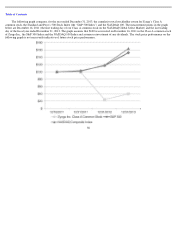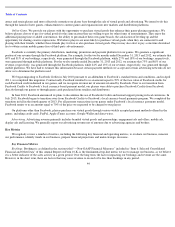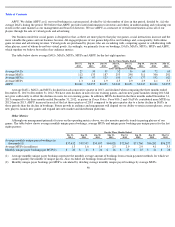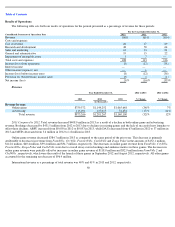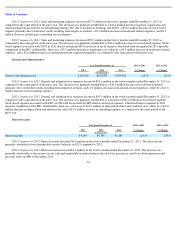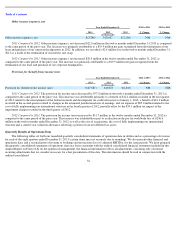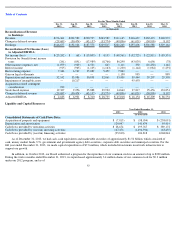Zynga 2013 Annual Report Download - page 52
Download and view the complete annual report
Please find page 52 of the 2013 Zynga annual report below. You can navigate through the pages in the report by either clicking on the pages listed below, or by using the keyword search tool below to find specific information within the annual report.
Table of Contents
In the fourth quarter of 2013, we hired Clive Downie, as our Chief Operating Officer.
Factors Affecting Our Performance
Changes in Facebook Agreements.
Facebook is the primary distribution, marketing, promotion and payment platform for our social games.
We generate a significant portion of our bookings, revenue and players through the Facebook platform and expect to continue to do so for the
foreseeable future. Facebook and other platforms generally have the discretion to change their platforms, terms of service and other policies with
respect to us or other developers, and those changes may be unfavorable to us.
Launch of new games and release of enhancements . Our bookings and revenue results have been driven by the launch of new mobile and
web games and the release of fresh content and new features in existing games. Our future success depends on our ability to launch successful
new hit titles on mobile platforms. Although the amount of revenue and bookings we generate from a new game or an enhancement to an
existing game can vary significantly, we expect our revenue and bookings to be correlated to the success and timely launch of our new games
and our success in releasing engaging content and features. In addition, revenue and bookings from many of our games tend to decline over time
after reaching a peak of popularity and player usage. We often refer to the speed of this decline as the decay rate of a game. As a result of this
decline in the revenue and bookings of our games, our business depends on our ability to consistently and timely launch new games that achieve
significant popularity and have the potential to become franchise games.
Game monetization . We generate most of our bookings and revenue from the sale of virtual goods in our games. The degree to which our
players choose to pay for virtual goods in our games is driven by our ability to create content and virtual goods that enhance the game-play
experience. Our bookings, revenue and overall financial performance are affected by the number of players and the effectiveness of our
monetization of players through the sale of virtual goods and advertising. For example ABPU increased from $0.050 in the twelve months ended
December 31, 2012 to $0.053 in the twelve months ended December 31, 2013, due to a decline in DAU of non-paying players (versus paying
players) who do not contribute to online game bookings and due to a lower decline in advertising bookings as compared to the decline in DAU.
In addition, mobile and international players have historically monetized at a lower level than web and U.S. players, respectively, on average.
The percentage of paying mobile and international players may increase or decrease based on a number of factors, including growth in mobile
games as a percentage of total game audience and our overall international players, localization of content and the availability of payment
options.
Investment in game development . In order to develop new games and enhance the content and features in our existing games, we must
continue to invest in a significant amount of engineering and creative resources. These expenditures generally occur months in advance of the
launch of a new game or the release of new content, and the resulting revenue may not equal or exceed our development costs.
Player acquisition costs. We utilize advertising and other forms of player acquisition and retention to grow and retain our player audience.
These expenditures generally relate to the promotion of new game launches and ongoing performance-based programs to drive new player
acquisition and lapsed player reactivation. Over time,
48
•
2013 Restructuring.
In 2013, we implemented restructuring plans that included a reduction in work force of approximately 550
employees and the closure of certain data center facilities and offices as part of an overall plan to reduce our long term cost structure.
In total, we recorded restructuring charges of $44.7 million in 2013.
•
Stock Repurchase Program.
In October 2012, our Board authorized a program for the repurchase of our common stock in an amount
of up to $200 million. During 2013, we repurchased approximately 3.4 million shares of our common stock for $9.3 million under
our 2012 program, and as of December 31, 2013, the remaining authorized amount of stock repurchases that may be made under the
program was $178.9 million.


